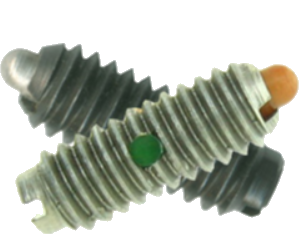
Spring plungers are commonly used for positioning-related applications. They are found machines where they “position” specific parts. As shown in the adjacent photo, spring plungers consist of a metal body with a ball at the end. Within this body is a spring. To learn more about spring plungers and how they work, keep reading.
How Spring Plungers Work
Spring plungers leverage the mechanical energy stored by a spring to position, as well as lock, parts in place. All spring plungers have a spring. After all, that’s why they are known as “spring plungers.” They specifically have a compression spring, which is housed inside of a metal body.
Compression springs are designed to become shorter under pressure. When a load is placed against a compression spring, it will become shorter. At the same time, the compression spring will attempt to push back out to its original size, thereby exerting a force. Spring plungers leverage a compression spring to position and lock parts in place. The ball will recede into the body, resulting in the compression spring becoming shorter. The ball will then press back out against the part with which it’s used.
What Materials Spring Plungers Are Made Of
If you’re planning to buy a spring plunger, you’ll need to choose the right material. Spring plungers are available in different materials. Steel is one of the most common materials in which spring plungers are made. There are carbon steel spring plungers, and there are stainless steel spring plungers. The former type is typically stronger and more durable. Stainless steel spring plungers, on the other hand, are better protected against corrosion.
You can also find spring plungers made of brass. Brass is both strong and corrosion resistant. These properties make it a popular choice of material for spring plungers. While most spring plungers are made of metal, this isn’t the case for all of them. Some spring plungers are made of nylon. Nylon is a synthetic material with properties similar to those of plastic.
How Spring Plungers Are Installed
Most spring plungers are installed with either a screwdriver or a drive socket. The way in which a spring plunger is installed will depend on it head. The head is the end of a spring plunger that’s opposite to the ball. Spring plungers typically have a head that supports either a screwdriver or a drive socket. You can use the appropriate tool to install or remove spring plungers.
